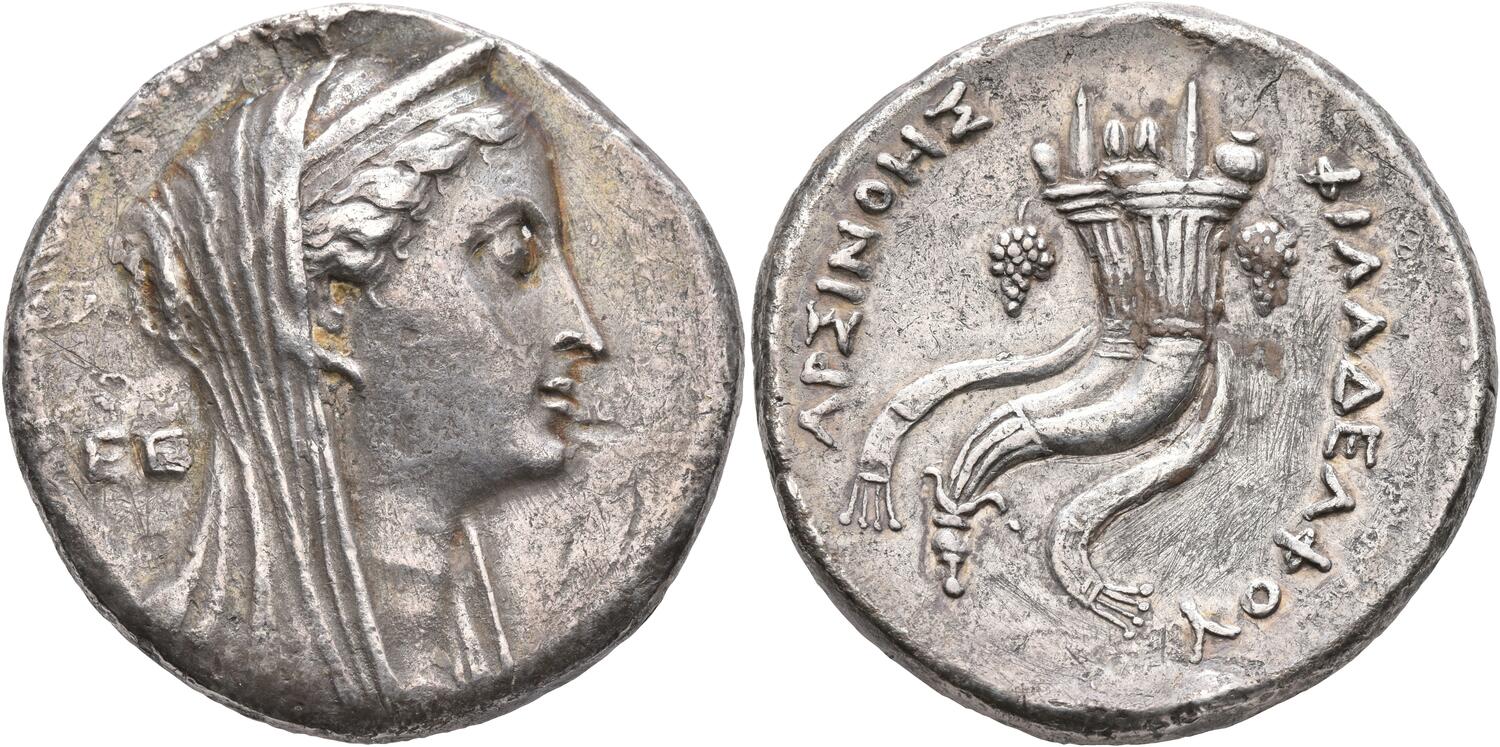H 313 - Alexandria (Ptolemy III-Arsinoe), silver, decadrachms (246-221 BCE)
From SILVER
246 BCE - 221 BCE Silver 24,564 kg
Description
| ObverseInscription or printing placed on the obverse.: | Diademed and veiled bust of deified Arsinoe II with ram's horn to right, with the tip of a lotos scepter at the top of her head, behind to left, EE |
| ReverseInscription or printing placed on the reverse.: | ΑΡΣΙΝΟΗΣ ΦΙΛΑΔΕΛΦΟΥ (Greek).Double cornucopiae bound with fillet and with two grape bunches hanging at sides |
Mint and issuing power
| MintIdentifies the place of manufacture or issue of a numismatic object.: | Alexandria | Ancient regionAncient region.: | Egypt | Modern countryModern country: Egypt | AuthorityIdentifies the issuing power. The authority can be "pretended" when the name or the portrait of X is on the coin but he/she was not the issuing power. It can also be "uncertain" when there is no mention of X on the coin but he/she was the issuing power according to the historical sources: | Ptolemy III Euergetes (Ptolemaic king, 246-222 BC), Ptolemaic dynasty (323-30 BC) |
Chronology
| FromIdentifies the initial date in a range assigned in a numismatic context. | 246 BCE | toIdentifies the final date in a range assigned in a numismatic context.. | 221 BCE | PeriodTime period of the numismatic object.: Hellenistic 323-30 BC |
Physical description
| MetalThe physical material (usually metal) from which an object is made.: | Silver |
Median weightMedian of the weights of numismatic objects (in grams). in grams | 35.60 | DenominationTerm indicating the value of a numismatic object. Examples: tetradrachm, chalkous, denarius.: | decadrachm |
StandardStandard.: | Ptolemaic |
Image

H313 Ptolemy III decadrachm.jpg [1]
References
| Die study referencePublication of the study: | Van Driessche 19871Van Driessche 1987 | ||
| Coin series referenceReference to coin series study: | Sear II2Sear II, n° 7803, RQEMH3RQEMH, n° 313, CPE I4CPE I, n° 347 | ||
Obverse dies distribution
| FrequencyFrequency of specimen in distribution. ᵖ | Number of obversesNumber of obverse dies. ᵖ (o) | % (o) | Number of coinsNumber of coins. (n) | % (n) | Die nameName(s) of the die(s). |
| 1 | 7 | 24.14 | 7 | 6.54 | 1/GG, 1/ZZ, 2/MM, 1/PP, 2/SS, 1/TT, 1/A |
| 2 | 8 | 27.59 | 16 | 14.95 | 2/BB, 1/DD, 1/NN, 1/JJ, 1/SS, 1/FF, 1/XX, 1/CC |
| 3 | 3 | 10.34 | 9 | 8.41 | 1/HH, 1/LL, 1/RR |
| 4 | 4 | 13.79 | 16 | 14.95 | 1/YY, 1/II, 1/KK, 1/OO |
| 5 | 1 | 3.45 | 5 | 4.67 | 1/UU |
| 7 | 3 | 10.34 | 21 | 19.63 | 1/AA, 1/VV, 1/B |
| 10 | 2 | 6.9 | 20 | 18.69 | 1/BB, 1/MM |
| 13 | 1 | 3.45 | 13 | 12.15 | 1/EE |
| Total | 29 of 29 | 100 | 107 of 107 | 99.99 |
Reverse dies distribution
no distribution is available
Quantification
| Number of obversesNumber of obverse dies. ᵖ (o) | 29 | Number of singletons (o1)The number of singleton coins. ᵖ | 7 |
| Number of reverse diesNumber of reverse dies. (r) | 70 | Number of coinsNumber of coins. (n) | 107 |
| Coins per obverse dieNumber of coins per obverse die. (n/o) | 3.69 | Coins per reverse dieNumber of coins per reverse die. (n/r) | 1.53 |
| Reverse per obverse ratioRatio of obverse dies divided by reverse dies. (r/o) | 2.41 | Percentage of singletons (o1)number of coins (n) divided by the number of singletons (o1) ᵖ | 24.14 % |
| Original number of dies (O) (Carter 1983 formula)The estimation of the number of coins according to Carter 1983 ᵖ | 34.5 | Coins struck if 20,000 as average productivity per dieCoins made if the average productivity for obverses (according to Carter) is 20,000. ᵖ | 690,000 |
| Original number of dies (O) (Esty 2011 formula)The estimation of the number of coins according to the singleton formula in Esty 2011 ᵖ (O) | 39.78 | Survival rate if 20,000 as average productivity per dieSurvival rate if average productivity is 20,000. ᵖ | 0.00016 |
| Coverage (o = % of O) (Esty 1984 formula)Esty 1984 - coverage (% of O) ᵖ (o = % of O) | 93.46% | Die productivity if survival rate 1/2,000Average productivity if survival rate is 1/2,000. ᵖ | 6,202.9 |
| Weight of silver (in kg) if 20,000 coins per die (O = Carter formula)Carter 1983 * Median weight * 20000 (*10 if gold or electrum) ᵖ | 24,564 kg <br /> 24,564 kg | Die productivity if survival rate 1/5,000Average productivity if survival rate is 1/5,000. ᵖ | 15,507.25 |
Remarks